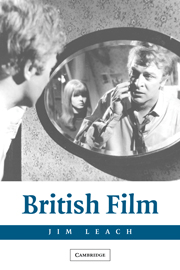Book contents
- Frontmatter
- Contents
- Acknowledgments
- Introduction
- 1 The National Health: Great Britain/Deep England
- 2 The Magic Box: What Is British Cinema?
- 3 The Common Touch: The Art of Being Realistic
- 4 The Mirror Crack'd: British Expressionism
- 5 Millions like Us: National Cinema as Popular Cinema
- 6 The Stars Look Down: Acting British
- 7 No Sex Please – We're British: Sex, Gender, and the National Character
- 8 Carry On Regardless: The British Sense of Humor
- 9 Sexy Beasts: British Monsters
- 10 The Ruling Class: Ideology and the School Movie
- 11 The Long Memory: History and Heritage
- 12 I'm British but … : Empire and After
- Notes
- Bibliography
- Filmography
- Index
2 - The Magic Box: What Is British Cinema?
Published online by Cambridge University Press: 07 May 2010
- Frontmatter
- Contents
- Acknowledgments
- Introduction
- 1 The National Health: Great Britain/Deep England
- 2 The Magic Box: What Is British Cinema?
- 3 The Common Touch: The Art of Being Realistic
- 4 The Mirror Crack'd: British Expressionism
- 5 Millions like Us: National Cinema as Popular Cinema
- 6 The Stars Look Down: Acting British
- 7 No Sex Please – We're British: Sex, Gender, and the National Character
- 8 Carry On Regardless: The British Sense of Humor
- 9 Sexy Beasts: British Monsters
- 10 The Ruling Class: Ideology and the School Movie
- 11 The Long Memory: History and Heritage
- 12 I'm British but … : Empire and After
- Notes
- Bibliography
- Filmography
- Index
Summary
In the final sequence of The Magic Box (John Boulting, 1951), William Friese-Greene, the British inventor, whom the film depicts as an unacknowledged pioneer of motion pictures, attends a meeting of film exhibitors in 1921. He pleads with them to support British producers rather than follow the economic logic that encouraged them to show more popular and less costly Hollywood films. After making his impassioned speech to no avail, Friese-Greene drops dead, creating a powerful allegorical ending that translates the story of an individual who lacks the practical sense to exploit his own invention into the depiction of a national culture that fails to support its own cultural industries.
The Magic Box was the film industry's contribution to the Festival of Britain, with many leading actors appearing in cameo roles, designed to mark “the contribution made by the cinema to the life of the nation.” It did indeed celebrate the life of a British film pioneer whose work had been overshadowed by other more famous inventors, such as the Lumiere brothers in France and Thomas Edison in the United States, somewhat distorting the historical record to make Friese-Greene's work seem more important than it actually was. However, a film about missed opportunity does seem a somewhat odd choice for such a celebratory occasion.
Raymond Durgnat compares this film with Scott of the Antarctic (Charles Frend, 1948) to support the idea that “the British could hardly respond to the idea of success without an aura of failure surrounding it.”
- Type
- Chapter
- Information
- British Film , pp. 30 - 47Publisher: Cambridge University PressPrint publication year: 2004



